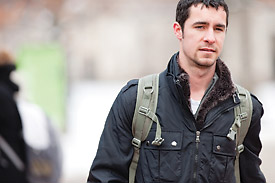Thousands of student veterans around the country found themselves squeezed between implementation delays and real-world deadlines for tuition, books, rent and food when the Post-9/11 Veterans Educational Assistance Act (the “New GI Bill”) went into effect in August 2009.

Doug Prough, a six-year veteran of the Michigan Army National Guard and a current student. Photo by Austin Thomason, U-M Photo Services.
“We were reading about major implementation problems just about everywhere in the country,” says Philip Larson, transition specialist in the Office of New Student Programs and head of U-M’s student veterans support network housed in ONSP.
But not at U-M, where a multi-departmental group teamed up to deliver support to student veterans.
“I was excited about the new GI Bill, but also wary of the VA’s ability to handle the number of applications they would receive. So I made sure I was one of the first to apply,” says Douglas Prough, a six-year veteran of the Michigan Army National Guard who was deployed for 18 months in support of the Kosovo Peace Keeping Force. Prough will complete his Bachelor of Arts in economics in 2010.
“My (certification) letter arrived right before classes started in September, and I was really surprised to see that the university already had credited my account the amount I would be receiving from the VA. The action by the university to go through each student veteran’s account and create this credit was invaluable and greatly appreciated.”
“I knew we would rise to the occasion,” says Lester Monts, senior vice provost for academic affairs. “Our student veterans earned these benefits, and university staff make sure our students are the priority.”
Initial notification of the new benefits program arrived from the Department of Veterans Affairs in January 2009. Students could begin to apply in May; but the VA’s procedural details were not available until June.
“We could see the potential for a serious logjam,” said Assistant University Registrar Christine Bedz. “With so little lead time, we were concerned about the adverse impact on our students if VA disbursements were delayed. We were determined to make our students’ experience seamless.”
With full appreciation of the operational complexity of the emerging program — including the related Yellow Ribbon tuition supplement, www.ur.umich.edu/0809/Jul27_09/17.php — staff from the Registrar, ONSP, Information and Technology Services, the offices of financial aid, student financial services and the Stephen M. Ross School of Business mapped out what they thought the new system would require.
They hit the bull’s-eye, producing a new process that provided common rules and procedures and, ultimately, a safe harbor for U-M’s student veterans.
In advance of VA benefit payments, the new process generated an immediate credit to tuition accounts of student veterans who had been certified by the VA and the Registrar. They also made sure funds were available for books, room and board.
“The opportunity to take out a 0 percent interest loan to cover other expenses was important, too, because many of us didn’t receive our first month’s allowance until November or December,” Prough says. “And a majority of us use this money to live on.”
The major administrative challenge was developing a way to share information among the several departments that had a role in the process.
“Because of the compressed time frame, leveraging our existing M-Pathways enterprise administrative system was key,” says Elaine Nowak, product manager, ITS. “The great news is that we were able to deliver real-time technical solutions and integrated data flow across offices at no additional cost to the university.”
In some instances, the VA took from 10 to 16 weeks to approve eligibility. “With a good faith expectation that these students would receive VA approval, we worked with students on a case-by-case basis to have financial holds released and other financial needs alleviated,” Larson says.
The process begins anew each academic term. “We are looking to the future to see if we need to tweak the system we have in place to anticipate growth in our student veteran population and to ensure we continue to deliver quality service to these students,” Nowak says.

